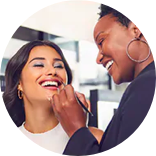Hello! Welcome to the start of your skincare journey, I hope it brings you much joy!
Let me start off by shamelessly re-posting my Beginner Skincare Commandments and I'll touch on some of your specific issues.
Commandment The First: Thou Shalt Patch Test.
I know, I know, your new stuff is finally here and you can't wait to get started, but after you've opened everything up there's one thing you must do before you start slathering it on your face. Patch Testing. Good news: You can do it right away after getting your products. Bad News: Then you have to wait. The purpose of patch testing is to test for skin reactions to new products.
Even if your skin is generally non-sensitive you may have an unknown allergy to something that will cause you weeks of pain, irritation and confusion. I know this because I've done it. Turns out, I'm allergic to propylene glycol so even my "bring on the 25% AHA peels I laugh in the face of chemical burns" skin turned into a "water hurts me" mess. If I'd patch tested I would have been able to pinpoint the source of my reaction right away rather than muddle through a week of breaking out, skin cracking, and general suffering.
To patch test you want to take a small amount of the product and apply it to an area of thinner skin. You could patch test on your face, but the idea is to avoid a face full of irritation, so the underside of your chin is a great place to use instead. You can patch test multiple products at the same time, just remember what you put where so if there's irritation you know which is the cause. You're looking for redness, flaking, itching, stinging, or any difference in your skin.
Commandment The Second: Study Closely Thine Holy List Of Ingredients.
Products are made of things, and those things are legally required to be listed on the packaging. They will always be in descending order so the first ingredient makes up the most of the product (it's usually water, and that's totally fine). Now the exact amounts are a bit funky, and anything past the first five or six ingredients isn't going to make up more than 1% of the product. This is important because some places will try to tell you that any amount of alcohol in a product will dry your skin out when it generally isn't enough to be even noticeable to you (it's to kill bacteria and mold usually). Other products will tout "key ingredients" that make up less than 1% of the product.
My 20% vitamin C serum's ingredient list goes like this: "Deionized Aqua (Water), Organic Aloe Barbadensis Leaf,Sodium Ascorbyl Phosphate (Vitamin C), Methylsulfonylmethane (MSM), Cassia Angustifolia Seed Polysaccharide (plant-derived hyaluronic acid,11%)...". That's 6 ingredients and the third one down is 20% of the item, so even if the water and aloe are 22% and 21% respectively and the MSM is say 15% those six ingredients make up 89% of the product. The water is almost certainly actually at least 40% and anything below these on the list will be highly unlikely to be above 2%. Now, this is not to say that 1% concentrations are definitely worse than higher. Some ingredients like retinol and salicylic acid are fine at 1% or lower concentrations. Others like niacinimide and vitamin C do their best work at 5-15%.
Luckily, some brands sell themselves on being backed by research and transparent about the purpose of their ingredients, so we have things like Paula's Choice's Ingredient Dictionary: . I use this to look up anything I'm unfamiliar with to see if it's actually useful.
Commandment The Third: Be Thou Wary Of Vaugeries And Fearmongering.
When you can't sell your products with facts, you try to scare consumers away from the competition. terms like "Clean" and "Natural" have no regulated or even consistent definition. "Toxins" are literally meaningless and even specific claims (particularly about endocrine disruption or cancer-causing) are usually based on studies where researchers fed the substance to rats in quantities higher than you would ever encounter in real life. If there was any demonstrated risk of harm to humans it would not be in a product you put on your face. Websites like EWG are particularly bad for this. EWG's Skin Deep database literally lists every product as "Data limited" with at least a scary 3 or 4 on their safety scale unless that brand pays them to "asses" the products and give them a good grade. It also does not account for the amount of the ingredient in a product and lists them instead in order of scariest claim first.
Beware also of claims like "helps to" and "reduces the look of". These are weasely words that companies use to say the product does things that it simply cannot do. A product that "reduces the appearance of fine lines" usually does this by covering the fine lines with a layer of silicone, giving a smooth appearance rather than actually making your skin smoother. Antioxidants is a similarly vague category that stretches "reduces oxidative stress on the skin that causes premature aging" into "helps prevent and reduce/reverse skin aging". This doesn't mean either of those products are bad, mind you, it just means that you need to be aware of what the ingredients actually do more than the claims made by products.
Commandment The Fourth: Thou Shalt Begin Simply.
Have I made your head spin yet? Does it all sound a lot like the worst parts of chemistry class but the grade is shown on your face? Don't worry, most of the previous two Commandments is a base so that you don't get swept in by excessive or misleading marketing jargon. You don't actually need to know any of the names and effects of any products right now. You're going to begin with the basics and build from there. These basics are only three products: Cleanser, Moisturizer, and Sunscreen.
Since you mention being acne-prone I would also suggest getting a BHA (Beta Hydroxy acid, aka Salicylic acid) exfoliant. AHAs are good for raw exfoliation, but BHAs are oil-soluble and can therefore get into your pores, which AHAs can't do. You want specifically a leave-on toner-style liquid or a mask that has a clay base to absorb that excess oil (cleansers don't stay on your face long enough to be effective). Paula's Choice Skin Perfecting 2% BHA Liquid Exfoliant 4 oz/ 118 mL or The Ordinary Salicylic Acid 2% Masque 1.7 oz/ 50 mL are two great examples and while you could use both, you want to start with just one. If you also want a spot treatment for breakouts something like Kate Somerville EradiKate 1 oz/ 30 mL or Paula's Choice CLEAR Daily Skin Clearing Treatment with 2.5% Benzoyl Peroxide 2.25 oz/ 67 mL are good for treating the actual zit you see. Many spot treatments are just salicylic acid which doesn't do much for getting rid of the zit, once it's red and visible (rather than just a blocked pore) only sulphur and Benzoyl peroxide actually help eliminate it.
There's three reasons for this. Firstly, diving into a massive extensive routine is expensive, and you'll be doing a lot of experimentation. Secondly, massive routines take tons of time, and that makes you less likely to stick with the routine. You're also less likely to enjoy the process and that's in important part of it! This should be self care, not self-flagellation. Thirdly, the fewer products you start with, the less likely you are to irritate your skin with a new product.
Commandment The Fifth: Thou Shalt Keep It Simple.
Once you have your three pillars established you can expand your routine to fit your needs. When you're focusing on specific things it's a lot easier to find the ingredients and types of products that will best suit you. Again, since you said you were acne prone I'd look into retinol once you've got your Basics settled, the increased skin turnover is also great for acne. While a lot of retinol products are expensive they don't need to be, The Ordinary Retinol 0.2% in Squalane, Signs of Aging Serum 1 oz/ 30 mL or The INKEY List Retinol Fine Lines and Wrinkles Serum 1 oz / 30 ml are both low-cost retinols that you can try out. You may also want to add an AHA if you find that your rough skin texture isn't solved by the BHA and regular moisturizing. You also may have oily and dehydrated (unlike dry skin, which lacks oil) skin which I also have, and that can change how you treat it (after your Basics are established). This video can help explain it:
Doing your own research and exploring products through samples and the like will be really helpful for keeping the price down too. I find the work of Michelle at Lab Muffin Beauty Science (Chemistry PhD and skincare nerd Blog: to be great for learning what the science actually supports. I also like Gio at Beautiful with Brains: as she is similarly focused on skincare based in actual results rather than marketing. I find her recommendations lean a bit more expensive but the base of knowledge is solid.














